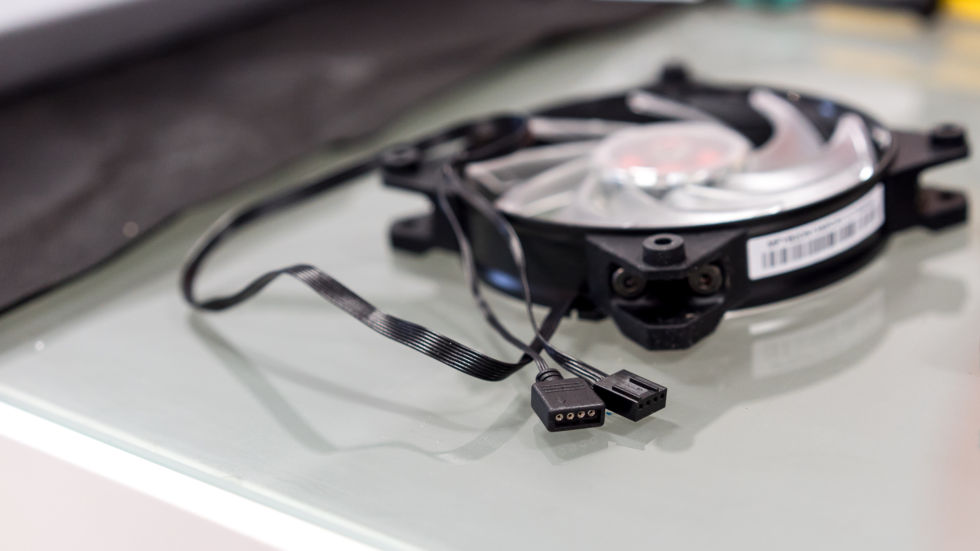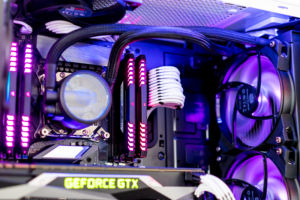
Corsair has a lot to answer for.
In 2014, the PC parts specialist debuted the world's first mechanical keyboard with Cherry MX RGB switches. The idea, according to Corsair, was to provide the ultimate in keyboard customisation by individually lighting each key with an LED capable of displaying one of 16.8 million colours. Coupled with some bundled software, users could light up the WASD keys in a different colour for use with shooters, turn the number key row into a real-time cool-down timer, or turn the entire keyboard into a garish music visualiser. Unfortunately for Corsair, so bad was the bundled software that most people simply took to setting the keyboard up with the most eye-searing rainbow effect possible and called it a day.
Which brings us neatly onto the current state of the enthusiast PC. What started with a single keyboard has grown into an industry of RGB-capable components, peripherals, and cases designed for maximum levels of rainbow-coloured nonsense. Indeed, alongside the inclusion of tempered glass side panels, RBG lighting has been the de facto trend for 2017—so much so that it's harder to find components without the tech rather than with it.
Until recently, however, getting all those RGB components to work together has been a slog. There are proprietary standards like Corsair Cue, wacky connectors like those on Phanteks' RGB strips, and components that require special breakout boxes in order to function, like Thermaltake's eye-catching Riing fans. What has changed is that motherboard-makers have finally gotten 'round to integrating standardised RGB connectors and controllers into their motherboards, providing a central hub for all RGB components, and—with the help of software—a way to sync them all together for all manner of flashy visual effects.
While I've personally never been a fan of the garish gamer aesthetic, in the spirit of trying something new as the industry hits peak RGB, I'm giving RGB a go. And not just any old RGB. I've assembled a collection of the biggest and best RGB components the industry has to offer, from motherboards and memory through to keyboards and monitors (yes, there are monitors with RGB lighting). And even if you're not into overblown desktops, as this tutorial should hopefully explain, there are ways to make tasteful RGB systems that don't descend into explosions of colourful unicorn vom.
Let's talk about standards
Contrary to what some component manufacturers might have you believe, there is something of a standard for RGB lighting, which originated from its use in home interiors rather than desktop computer systems. It's a simple four-wire connector with male and female ends, with the wires divided into red, green, and blue signals (hence, RGB), and a 12V line for power. Most LED strips for the home use the connector, which typically has an arrow to indicate which wire is the 12V wire. This matters, because some component manufacturers have decided to implement their own version of the RGB standard, which often changes the order of the wiring, even if the connector itself is identical.

| RGB System Specs | |
|---|---|
| CPU | Intel Core i9-7900K @4.5GHz |
| RAM | Corsair Vengeance RGB DDR4 @ 3200MHz |
| HDD | Corsair MP500 480GB M.2 SSD |
| Motherboard | Asus ROG Strix X299 Gaming-E |
| Power Supply | Corsair HX1200i |
| Cooling | CoolerMaster MasterLiquid Pro 280 |
| Fan | CoolerMaster MasterFan Pro RGB |
| Peripherals | Asus ROG Claymore Core keyboard, ROG Pugio mouse, ROG Strix XG27VQ monitor |
Motherboard vendors typically use the standard connection, although even then there are differences. Gigabyte uses a five-pin RGB connector, with the fifth pin reserved for use with LED strips that use a dedicated white LED, instead of blasting out all the colours together to simulate white. Fortunately, it uses the default 12V GRB order for wiring, which also features on Asus and MSI motherboards.
The best way to tell if your RGB components will work together is to simply consult your preferred motherboard-maker's compatibility page, like Asus Aura. For the most part, all the listed components will either use the standard RGB connector or—like in the case of Phantek's RGB strips—can be converted to do so with a readily available adaptor.
At the time of writing, the Asus Aura list has expanded to cover dozens of different components and manufacturers, including the likes of InWin, CableMod, Bitfenix, CoolerMaster, and Akasa. There are multiple cases with built-in RGB lighting that work with Asus' Aura Sync software, along with RGB strips, case fans, coolers, and even memory and power supplies. Most components use a three-pin RGB connector to function, although some components like memory don't require it at all. Both G.Skill RGB memory and Corsair Vengeance RGB memory communicate directly with the motherboard, which makes for a clean installation (Geil memory, by contrast, requires you to run an unsightly cable to each memory stick).

Most motherboards come with two RGB headers, each supplying 12V of power. However, if you have a particularly large PC case that you plan on filling with multiple RGB fans, each requiring its own header, this quickly becomes a problem. Some fans, like In Win's Aurora range, can be daisy-chained together but require a separate breakout box to provide power and avoid overloading the 12V connection on the motherboard. Third-party solutions like Silverstone's LSB01 are also an option, which splits a single RGB header into eight while supplying extra power via a molex connector.
Unfortunately, the LSB01 costs a hefty $35/£35, but it does come with a pair of RGB LED strips. A cheaper option, should you have more modest needs, is to split the RGB headers in two. Cables like this four-pin splitter from Amazon, which costs a mere $5/£4 for two, work perfectly.
reader comments
85